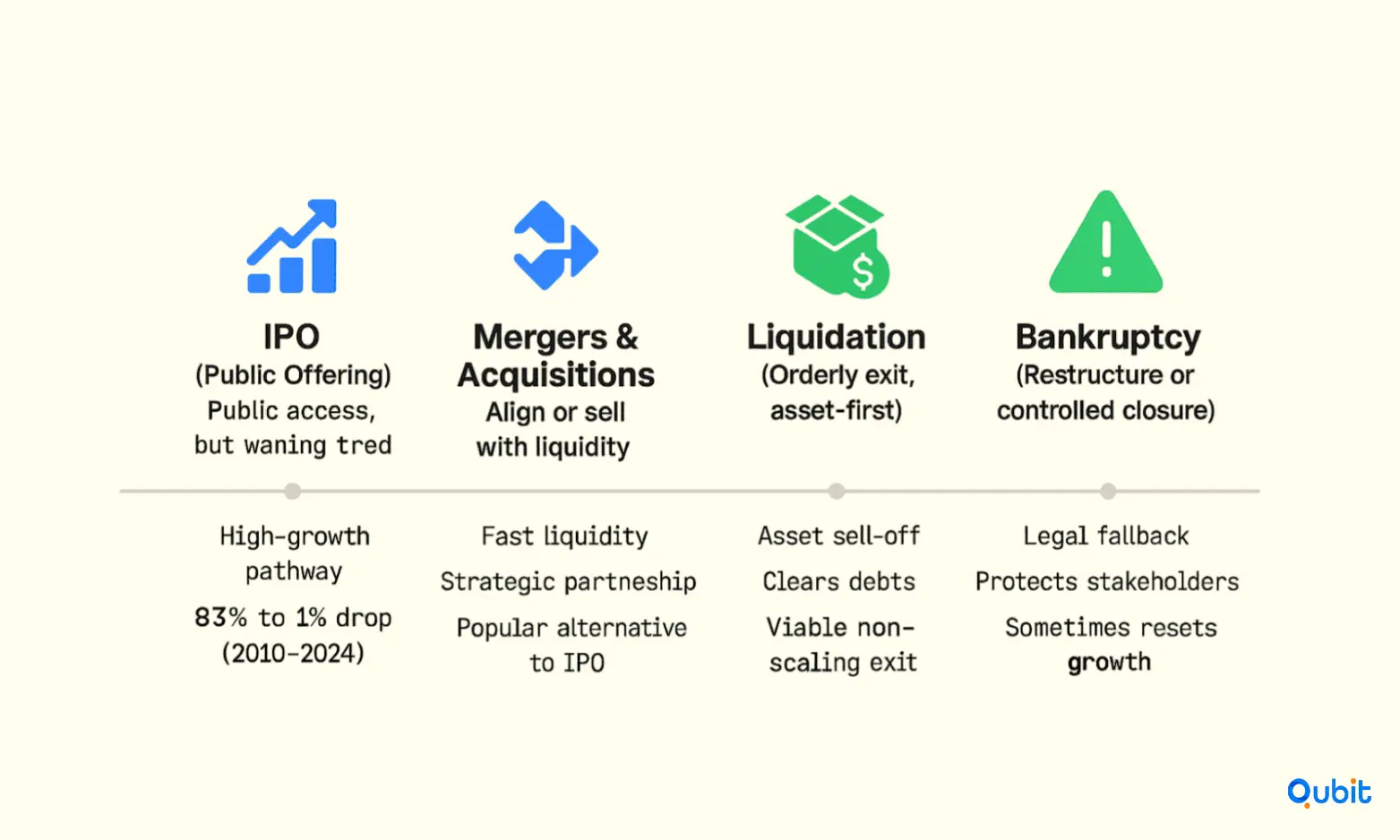Every business journey begins with a vision, but it’s the exit strategy that ensures a rewarding conclusion. Whether you’re an investor seeking to maximize returns or a startup founder planning to scale, understanding exit strategies is essential. These strategies outline how stakeholders can "cash out" their investments, paving the way for financial gains or new opportunities.
To grasp the fundamentals, it’s crucial to first understand the role of investors in these scenarios. Additionally, a thorough overview of how to do startup outreach for investors presents foundational strategies that align early engagement with subsequent exit considerations.
This blog explores why exit strategies matter, the options available, and how they shape the future for businesses and their backers.
Defining Your Exit Strategy
An exit strategy is more than just a financial decision; it’s a carefully crafted plan that determines how and when to liquidate investments or business interests. Whether the goal is to maximize gains or minimize losses, having a predetermined strategy ensures clarity and control over financial outcomes. For investors, this could mean selling stocks at a specific price point, while for business owners, it might involve selling the company or transferring ownership under defined conditions.

The importance of a well-communicated exit plan cannot be overstated. Clear communication ensures that all stakeholders—whether they are business partners, investors, or employees—are aligned with the objectives and timing of the exit. This alignment reduces uncertainty and fosters trust, which is critical during high-stakes transitions.
Risk management is another cornerstone of a successful exit strategy. By setting financial objectives early on, individuals and businesses can mitigate potential losses and capitalize on opportunities. For instance, understanding how to liquidate assets effectively is a key component of this process.
Ultimately, an exit strategy is not just about the end—it’s about planning for a smooth transition that aligns with your financial goals. By defining clear objectives and communicating them effectively, you can ensure that your exit is both strategic and successful.
Mastering the Timing of Your Exit Strategy
Timing plays a pivotal role in the success of any exit strategy. Whether you're an investor or a founder, understanding when to act can significantly impact the value you extract from your investment. Exit timing is not just about market conditions; it also involves managing emotional biases and adhering to predefined exit points.
The Role of Market Conditions
Market conditions often dictate the optimal moment for an exit. A favorable economic climate, industry growth trends, and buyer demand can all influence the timing. For example, the reported median holding period for assets, typically ranging from 5.9 to 7 years, highlights the importance of aligning your exit with market cycles. This timeframe allows investors to capitalize on growth while avoiding premature exits that could limit returns.
Managing Emotional Biases
Emotions can cloud judgment, especially when deciding to exit an investment. Fear of missing out or holding onto an asset too long can lead to missed opportunities. Predefined exit points, established during the initial investment phase, help mitigate these biases. By sticking to these benchmarks, investors can make decisions based on data rather than emotion.
Predefined Exit Points
Predefined exit points act as a safety net, ensuring that decisions align with long-term goals. These points are often based on key performance indicators (KPIs) that measure the health and growth of the investment.
Mastering the timing of your exit strategy requires a balance of market awareness, emotional discipline, and strategic planning. By understanding these factors, you can maximize the value of your investment and achieve your financial goals.
Exploring Exit Strategy Options and Real-World Examples
Exit strategies are pivotal for investors, business owners, and startups, offering a structured way to transition from ownership or investment. Depending on the business lifecycle, several exit options exist, including IPOs, mergers and acquisitions (M&A), liquidation, and bankruptcy. Each method serves distinct purposes and is tailored to specific circumstances.

Initial Public Offerings (IPOs)
An IPO allows a company to go public, offering shares to external investors. This strategy is often pursued by startups with high growth potential. However, the Shifting IPO Landscape reveals a decline in unicorn IPO exits, dropping from 83% in 2010 to just 11% in 2024. This trend highlights the growing preference for alternative exit mechanisms.
Mergers and Acquisitions (M&A)
M&A is a common route for businesses seeking to merge with or be acquired by another entity. This approach can provide immediate liquidity and strategic alignment.
Liquidation
Liquidation involves selling off assets to pay creditors and distribute remaining funds to stakeholders. While less glamorous than IPOs or M&A, it can be a practical option for businesses unable to sustain operations.
Bankruptcy
Bankruptcy is often a last resort, enabling businesses to restructure or dissolve under legal protection. Though it carries stigma, it can offer a fresh start or orderly closure.
Each exit strategy comes with unique implications for stakeholders. For insights into balancing growth and risk, explore startup-portfolio-management, which connects portfolio strategies with exit readiness.
Understanding these options empowers stakeholders to tailor their approach, ensuring a smooth transition aligned with their goals.
Strategic Planning for a Successful Exit
A well-structured exit plan is the cornerstone of a seamless transition, whether you're selling your business, merging, or stepping away. Robust exit planning not only safeguards long-term financial health but also minimizes risks during the process. By focusing on clear financial objectives, succession planning, and systematic documentation, business owners can set the stage for a successful exit.
1. Define Clear Financial Goals
Establishing precise financial objectives is the first step in exit planning. These goals should reflect both your personal aspirations and the future needs of the business. Whether you're aiming for a specific valuation or ensuring financial security post-exit, measurable milestones are essential. Starting early—ideally three to five years before the planned exit—provides ample time to align your business trajectory with these goals.
2. Prioritize Succession Planning
A solid succession plan ensures the business remains stable and operational during and after the transition. Identifying and preparing successors, whether internal candidates or external hires, is crucial. This process involves training, delegating responsibilities, and fostering leadership skills to maintain continuity. A well-prepared successor not only reassures stakeholders but also enhances the business's appeal to potential buyers.
3. Embrace Systematic Documentation
Comprehensive documentation is vital for due diligence and transparency. Using tools like Ansarada’s company exit software can simplify this process. This platform helps organize, maintain, and share critical information, ensuring that all necessary data is readily available for potential buyers or investors. Systematic documentation reduces delays and builds trust during negotiations.
4. Stay Flexible
Flexibility is a key ingredient in any successful exit strategy. Market conditions, buyer preferences, and unforeseen challenges can all influence the exit process. By maintaining adaptability, business owners can pivot their strategies to align with changing circumstances, ensuring a smoother transition.
For additional insights on refining your business strategies, check out our article on improve-startup-outreach. Continuous improvements in outreach and operations can significantly enhance your business's readiness for an exit.
Strategic planning for an exit is not just about the end—it’s about creating a roadmap that secures your legacy and financial future.
Further Resources and Exit Strategy Q&A
Timing an exit can be as critical as the strategy itself. This section dives into essential resources and answers common questions to help you refine your approach. Whether you're considering the impact on stakeholders or the steps required for seamless planning, these insights aim to clarify the complexities of exit strategies.
Optimal Timing for Exits
Determining the right moment to exit requires a balance between market conditions and business performance. Factors such as industry trends, financial health, and growth potential play a significant role. For example, exiting during a peak valuation period can maximize returns, but it’s equally important to assess internal readiness, including operational stability and leadership transitions.
Stakeholder Impact
Exits often ripple through the ecosystem of stakeholders, including employees, investors, and customers. Transparent communication is key to managing expectations and minimizing disruptions. For partial exits, alternative routes such as secondary sales can provide liquidity while maintaining stakeholder confidence. The review in secondary-sales-investor examines alternative exit avenues such as secondary sales, adding depth to your overall strategy.
Key Steps for Successful Exit Planning
- Define Objectives: Establish clear goals for the exit, such as financial targets or strategic partnerships.
- Evaluate Market Conditions: Conduct thorough research to ensure favorable timing based on industry trends.
- Prepare Documentation: Organize financial records, contracts, and operational data to streamline due diligence.
- Engage Experts: Collaborate with advisors to navigate legal, financial, and operational complexities.
- Communicate Effectively: Develop a communication plan to keep stakeholders informed and aligned.
Conclusion
A well-structured exit plan is more than just a strategy; it’s a roadmap to achieving your business goals while maximizing value. By focusing on clear objectives and actionable steps, you can ensure a smoother transition that benefits all stakeholders involved. The insights shared here highlight the importance of preparation, timing, and aligning your exit strategy with your long-term vision.
At Qubit Capital, we understand the complexities of planning an exit and the critical role of connecting with the right acquirers. If you’re ready to explore your exit opportunities further, our Investor Discovery and Mapping service can connect you with the right acquirers. Let’s get started.
Key takeaways
- Clearly define your exit strategy to mitigate risks and optimize gains.
- Timing and market conditions play a crucial role in exit success.
- Explore various exit options, including IPOs, M&A, and secondary sales.
- Comprehensive planning and goal setting are essential for a successful exit.
- Utilize digital tools and expert guidance to navigate the exit process.
Frequently asked Questions
What are the most common investor exit strategies?
Investors often use strategies such as IPOs, acquisitions, and secondary sales to exit, each offering distinct benefits and risks.


 Back
Back



